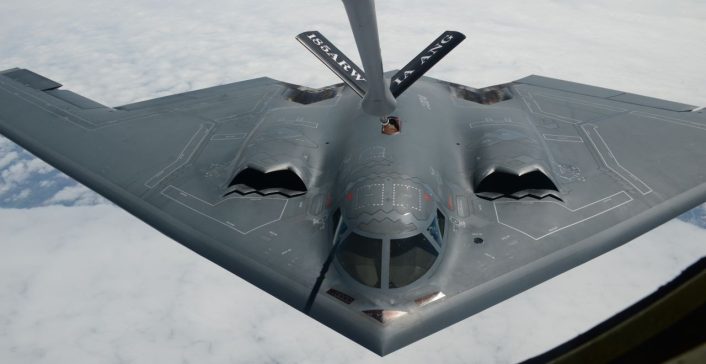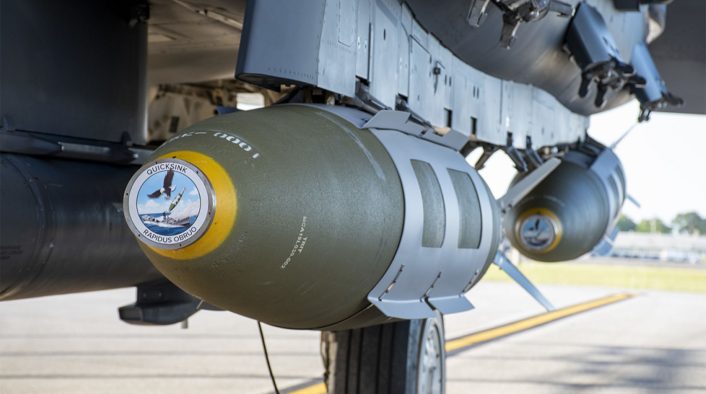The B-2 Spirit would be able to employ up to 80 500 lb QUICKSTRIKE weapons, holding at risk multiple targets in a maritime environment.
The U.S Air Force and the Air Force Research Laboratory (AFRL) announced on Jun. 4, 2025, the test of a “new, more versatile variant of the QUICKSINK maritime weapon,” based on a 500 pound GBU-38 JDAM (Joint Direct Attack Munition). The weapon was employed by a B-2 Spirit stealth bomber at the Eglin Air Force Base Gulf Test Range.
While it was not mentioned when the test took place, the VIRIN name assigned to the photos released on the DVIDS network said they were captured on Apr. 22, 2025. One of the photos shows a B-2 from Whiteman AFB, Missouri, as Airmen from the 393rd Bomber Generation Squadron prepare to load the weapon on the aircraft.
The latest test comes after the 2024 edition of the RIMPAC (Rim of the Pacific) exercise saw a B-2 Spirit demonstrating the QUICKSINK capability with a 2,000 pound GBU-31/B JDAM during the Sinking Exercise (SINKEX) component of the drills. That marked the very first time a B-2 Spirit was publicly reported to have employed this anti-ship capability. Previous QUICKSINK demonstrations in 2021 and 2022 saw F-15E Strike Eagles deploying modified 2,000-pound GBU-31 JDAMs.

Tactical utility and cost-benefit advantages
With the Air Force Test Center (AFTC) and Air Combat Command’s 53rd Wing also participating in the effort, the AFRL said the capability offers a “rapid response to maritime threats across vast ocean expanses, significantly bolstering the U.S. Air Force’s counter-maritime deterrence and operations.” The 53rd Wing commander, Col. Dan Lehoski, called the 500-pound QUICKSINK “an affordable, game-changing solution to rapidly and efficiently sink maritime targets.”
This variant “expands” the B-2’s targeting capabilities, and provides combatant commanders with an “expanded complement” of weapons for the role. The U.S. is obviously incorporating lessons from the naval wars in the Black Sea and the Red Sea.

The Russian and Western navies have been harrowed by the threat posed by cheaper Unmanned Surface Vessels (USV), one-way attack (OWA) drones, cruise missiles and anti-ship ballistic missiles, employed by Ukraine and the Houthis, respectively. The B-2s can carry 80 500-pound GBU-38 JDAMs, costing roughly $25,000, while the QUICKSINK seeker reportedly costs around $200,000. The price can be driven down to $50,000 upon increased production, AFRL officials told The War Zone.
The stealth bombers can work together with tactical jets like F-35Bs, F/A-18E/Fs, F-15Es and F-15EXs carrying the AGM-158C LRASM (Long-Range Anti-Ship Missile). For an instance, QUICKSINK missions with the greater magazine depths can damage or disable the smaller surface combatants protecting a PLA Navy Carrier Strike Group, while the fighters prosecute the larger vessels, or even China’s offshore bases in the South China Sea (SCS). This preserves LRASM stocks, roughly worth $2-3 million a unit, allowing U.S. Navy and U.S. Air Force fighters to have greater flexibility in prosecuting a naval war.
据美国海军学院新闻报道,环太军演中的高潮部分SINKEX击沉演习中,B-2隐身轰炸机使用了QUICKSINK快沉炸弹攻击了充当靶船的塔拉瓦号两栖攻击舰这是一种威力堪比重型鱼雷的武器(QUICKSINK见转推介绍)
PS:B-2无与伦比隐身性,载弹量和低成本的QUICKSINK大威力相结合,对解放军大型战舰构成巨大威胁 https://t.co/WKnehZIT74 pic.twitter.com/enxYtPDmQn
— 极光 (@Aurora107E) July 24, 2024
The B-2 Spirit’s stealth, with a much reduced risk of detection, can get closer to the targets. The weapon’s lack of an active seeker and low infrared signature leaves little trace for surface-to-air radar sensors to engage, increasing the chances to hit the target.
The AFRL also confirmed in 2022 that it had developed a dedicated seeker for the QUICKSINK role. The Chief of the AFRL’s Munitions Directorate, Col. Matthew Caspers, offered the doctrinal concept behind B-2 Spirit employing the new weapon: “QUICKSINK is the result of a Joint collaboration that rapidly prototyped an affordable concept for holding surface targets at risk.”
B-2 Spirits are poised to receive new upgrades under the “Spirit Realm 1” program, comprising an open mission systems architecture, new software, sensors and weapons to enhance the B-2’s survivability and combat capability. The possibility of the incoming B-21 Raider being also considered for maritime strike roles in the near future cannot be discarded.

Previous tests
The 2024 RIMPAC’s QUICKSINK demonstration with the B-2 used the GBU-31 JDAM’s existing GPS-assisted inertial navigation system (INS) guidance in the tail with a new radar seeker installed on the nose, combined with an IIR (Imaging Infra-Red) camera mounted in a fairing on the side.
Upon release, the bomb’s standard JDAM kit guided the weapon to the target area and the seeker/camera then locked on the ship. After locking on, the guidance system directeds the bomb to detonate near the hull, below the waterline.
An AFRL video of a QUICKSINK test, from Apr. 28, 2022 in the Gulf of Mexico, showed a decommissioned cargo carrier simulating a target of a “full-scale surface vessel” being hit in that exact spot, subsequently breaking in half. Footage from cameras both on the ship and overhead recording captured the impact.
Another Mar. 2022 concept video by the AFRL showed an F-35B dropping a QUICKSINK weapon from its internal bays on a container carrier disguised as a ballistic missile carrier.
Powered JDAM
JDAM’s developer Boeing has also announced developing a Powered JDAM (PJDAM), with a Kratos TDI J85 air-breathing engine, that fits on JDAM kits of 500 and 2,000 lb gravity bombs. The company’s description of the munition mentions it allows engagement from “outside anti-access/area-denial (A2/AD) systems’ effective ranges,” suggesting a clear maritime strike role. The weapon has undergone High Fidelity Wind Tunnel Testing in three configurations, which include a ‘Baseline PJDAM’, ‘Quickstrike Powered’ and a ‘Maritime Strike’ variant.
The PJDAM offers a range of over 300 nautical miles with a 500 pound warhead or 700 nautical miles with a “lost-cost decoy fuel tank.” Swapping out a warhead for fuel tank converts into a sort of loitering munition that can stay aloft longer, while possibly receiving targeting updates.
Jet-Powered JDAM Aims To Turn Bombs Into Cruise Missiles
The company is pitching the Powered Joint Direct Attack Munition (PJDAM) as a flexible and lower-cost cruise missile that can be used to attack targets on land and ones at sea. It could help countries, including the United… pic.twitter.com/0UxcWNGMcT
— Havoc Six (@Havoc_Six) October 25, 2023
An optional enhancement includes a 1.2 kW alternator for seekers and data link. Light disabling strikes on the sensor masts of warships or ground-based air defense radars in the opening stages of anti-maritime operations can be succeeded by follow-on LRASM or even NMESIS fires on PLA Navy surface combatants.









